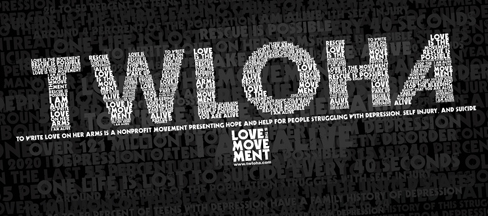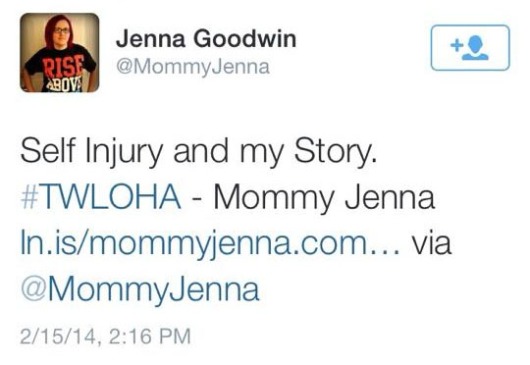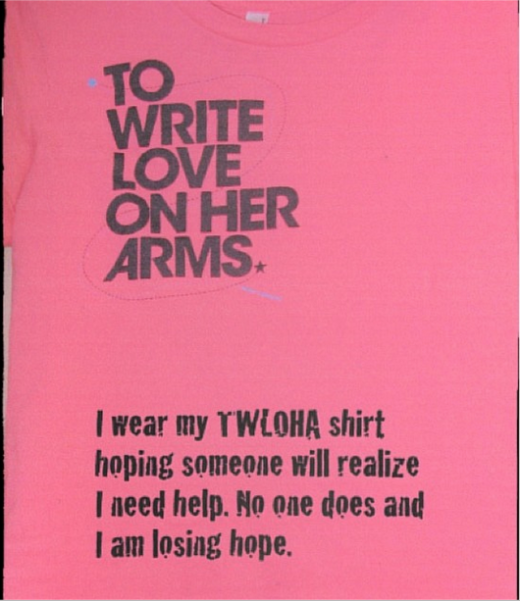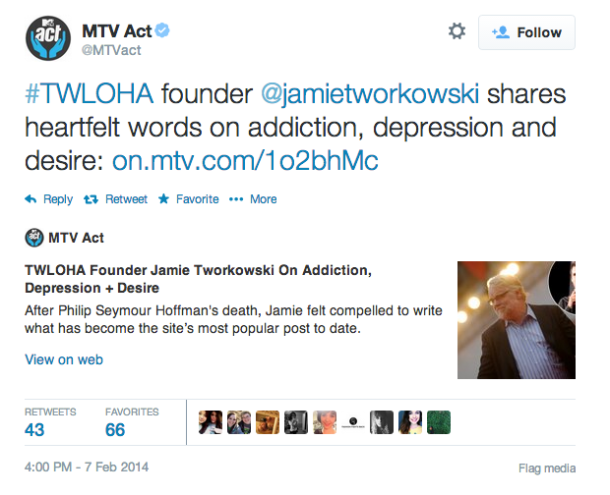An international non-profit organization just entering its 8th year, To Write Love on Her Arms strives to promote hope, help, and healing for individuals struggling with addiction, depression, self-injury, and thoughts of suicide while placing an emphasis directly onto treatment and recovery. This is an inclusive movement that welcomes all regardless of age, gender, sexual orientation, religion, race, ability, nationality, and so forth. According to To Write Love On Her Arms Online, In March of 2006, Jamie Tworkowski began taking the initiative of creating a personalized rehabilitation program from scratch through a support system based on love in order to help a friend heal when denied acceptance from a treatment center.
Therefore, there is a heavy emphasis on healing through the simply beautiful connection between people and the effect love can have on the mind. It is remarkable what this organization shows us we can do to change the world by showing individuals that they are important, that they are loved, and that they are not alone in their battle which allows us to come together as a whole. Simply being able to read the words of another person’s story going through a similar struggle allows society to open up and build acceptance— we can beat this mental health stigma when we begin sharing our stories which provides others with the freedom to share their own. This allows us to realize that it’s okay not to be okay and that it is okay to ask for help.
Thanks to the ever-growing use of the hashtag, #TWLOHA has become a theme trending on twitter and links the public to inspirational messages, personal stories, up and coming TWLOHA events, apparel merchandising, and much more. Further, the hashtag plays a critical role in the way users interact with each other and share their stories. The hashtag allows for easy access to short stories, articles, and messages of support to any person who can access the internet. This way, social networking allows this non-profit organization to expand and flourish in our ever-growing, tech-savvy era by providing a simple and very necessary public connection between people worldwide. Social media is also to thank for the consistent growth of TWLOHA – originally beginning in Florida, the on-the-go movement has since expanded to Poland, Australia, New Zealand, and Canada. Ultimately, one of the most significant impacts of the use of social networking in the area of the organization TWLOHA is to reframe/appropriate self-loathing into self-love and self-respect.
More specifically, TWLOHA is a movement that is about being open and honest about your struggles, so that those who are struggling with the same issues have someone to relate to and can feel encouraged and empowered. Twitter and the use of #TWLOHA play an important role in achieving those two objectives. Users can share their stories and in turn discover others’ stories of struggles and triumphs and possibly receive words of encouragement or encourage others. Additionally, those individuals opening up through being honest about their feelings are advancing their own process of recovery as well.
The phenomenon described above can be observed in a tweet by @Kararararara on April 1st of this year, “If being open about my struggles with depression and anxiety helps even one person, I can deal with those who judge me for it #TWLOHA.” According to an online database, Depression affects approximately 18.8 million adults in America every year. 15% of those 18.8 million will commit suicide, and it is projected that by 2020 it will be the second leading cause of death behind heart disease. What can we do to help those who have depression? @Kararararara is doing what more people should be doing, and that is speaking out about her depression despite what others may think. When someone speaks out about their depression, it allows three things to happen: first, it shows that they have acknowledged the problem, which is the initial step in overcoming a disorder. Second, it lets those out there with the same struggle know that they are not alone in this fight. Third and finally, it lets those around them who can help know about the issue and try to help.
A person who speaks out about their depression can get the help and support they need to battle the depression much sooner than someone who tries to hide it. #TWLOHA creates an avenue for those struggling to speak out and to find the help and support needed to overcome the depression. Besides receiving help, being open about your struggles with depression and anxiety does also help other people struggling through the same thing. The hardest thing in the world is to go through life feeling alone, especially if you suffer from depression. Knowing that there is at least one more person out there going through the same things as you can be enough inspiration and empowerment to allow you to fight through your own struggle. The more people that get together who share the same struggles creates a large support group that can impact both those struggling in the group and those who are outside and feel alone.
#TWLOHA was created to be that support group and safe haven for people going through struggles in life. Like @Kararararara, others can post with this hashtag to either open up about their struggles or to offer encouraging words to those who are struggling. Movements like #TWLOHA go a long way in helping those with depression overcome this terrible disorder. Depression is a vicious cycle of doubt and hopelessness, and the only way to truly break that cycle is through encouragement and inspiration. The user @Kararararara may have only thought that by speaking out she will only be helping one person, but in fact by her speaking out and other like her doing the same they will be helping countless people. If we ever want to break the projection of depression one day being the number two cause of death in this country, then we need more people like @Kararararara to be brave and to share their struggles.
Social media has been a mainstream connection between the TWLOHA movement and the individuals who come together to form one large support system. #TWLOHA does not only help to bring those struggling together, but it is also there to restore hope to the hopeless. The TWLOHA Twitter page tweeted a direct quote written by Kat Carlson in early March that explains it best: “I don’t think any friends of mine will truly understand how @TWLOHA saved my life. #WeWillBeTheHopeful #TWLOHA staying strong every day.” The To Write Love on Her Arms movement focuses on finding any help they can for people who struggle with depression, addiction, and self-injury or suicide. When researching the “#TWLOHA” hashtag on Twitter, it truly is amazing to see the amount of positive energy that circulates. Most of these individuals turn to social media as ways to express their gratitude or share a previous experience in regards to self-harms or the mental desire to commit suicide to those who can relate to them. Everyone has a story and using the #TWLOHA hashtag is a way to connect these hearts and provide a constant reminder that they’re not alone even though emptiness, at one point, was one of the strongest emotions they have felt. Kat Carlson, along with hundreds of thousands of other men and women turning to TWLOHA, expresses her gratitude by presenting the idea that this movement truly did save her life. How rewarding of a feeling must it be to join forces and fight this feeling with people who have walked a day in the life of your shoes? To be exposed to countless encouraging words that have the power to change an outlook on the mental and physical state of a suffering individual? To answer the question: life or death?
Jenna Goodwin, the writer of a February 15th blog titled “Self Injury and My Story” linked to her Twitter page, explains that feeling of recompense. Jenna writes, “In high school, I found myself cutting my flesh for the first time. I didn’t want to die. It wasn’t about wanting to end it or anything like that. It was a release I had never felt before.”
This sense of release is the end goal for the thousands of men and women causing self-harm to their bodies. It does not necessarily mean that taking a life is the goal, but rather a hope for some type of sensation that will take away the pain. Unfortunately, too many individuals find themselves causing themselves physical pain by searching for a way to end their mental struggles. Jenna Goodwin’s story is just one among thousands, but she does a miraculous job at explaining to the public how this foundation has truly changed her life. When Goodwin first saw posts for the To Write Love on Her Arms movement on social media sites such as Facebook, she cried because for once in her life she knew she was not alone. Posts such as “you were created to love and be loved” and “you need to know your life matters” were just a few of the encouraging statements that re-instilled the idea of a happy mind and living a life far from self-injury.
Similar to Jenna Goodwin, Jessika Marie tweets “I haven’t cut in 4 months. I haven’t burned in 2. I’m getting better I’m happy. #TWLOHA.” Jessika also included a picture of her wrist displaying her scars with the word “love” written over them. This is a popular trend in people who follow and support the To Write Love on Her Arms movement. To spread more awareness not only to the public but also to themselves, people will often write words such as “love”, “TWLOHA”, or “hope” on their wrist or on their body where scars may be apparent. The social media movement has assisted in tremendous ways. Those struggling with self harm can take advantage of the social media sites to participate in the engagement of empowering acts of both self-respect and self-love.
In addition to the hashtag, To Write Love on Her Arms has began to form campaigns throughout the year within their organization which are heavily promoted through the use of social networking sites – more specifically, Twitter. One of these effective up-and-coming campaigns is the hashtag #WeWillBeTheHopeful. This hashtag campaign was created in order to empower, inspire, and bring hope through words of motivation and encouragement. @Tuh_Rish_Uh tweeted on April 28th, 2014, “Be that person to someone else – a living, breathing, screaming invitation to believe better things #WeWillBeTheHopeful #TWLOHA”. This user is referencing a popular inspirational quote written by TWLOHA’s founder, Jamie Tworkowski, “You’ll need coffee shops and sunsets and road trips airports and passports and new songs and old songs but people more than anything else, you will need people and you will need to be that other person to someone else, a living breathing screaming invitation to believe better things”. Empowerment spread through social networking increasingly allows individuals to heal based off of public support provided through a public forum. Tweets such as this have the ability to link users to more TWLOHA information or to their official webpage where they will learn more about the movement and can continue to spread the word via social networking through hashtagging in order to continue the cycle. When people learn more about the movement, they will be able to understand additional ways that this movement flourishes through social networking such that the image below exemplifies:
Through a photo published via Instagram that an individual anonymously posted about losing hope, TWLOHA supporters came together as a community in order to show a single person that they had never met before how truly worthy and important to the world they are. Comments flooded the photo inspiring this individual to re-gain strength such as, “please speak up and remember that you are very special and important” and “You are so brave. And you matter. There is no one else like you”. Not only does TWLOHA link the public to personal stories and struggles, but to words of motivation in order to inspire others that there is a greater purpose to keep on fighting and keep on living.
Besides providing empowerment to people in need of it, it is worth noting how much the hashtag helps spread awareness about the cause in general. This is an important function to carry out, because it allows people that are not familiar with the cause gain more knowledge about it. For example, on February 7th, 2014, @MTCAct tweeted “#TWLOHA founder@jamietworkowski shares heartfelt words on addiction, depression and desire: http://on.mtv.com/1o2bhMc .“
This particular tweet stood out because it spread awareness about an event that had to do with the organization. This tweet leads to an article titled, TWLOHA Founder Jamie Tworkowski On Addiction, Depression + Desire. The article is a summary of some of the things Jamie discussed in his post on the organization’s website. The article also mentions the fact that Jamie gave a Ted Talk about asking people different questions to get to know them.
He was inspired by Jason Russell, one of the founders of Invisible Children, because he suggested getting to know people by asking “What is your dream?” instead of the standard “What do you do?” Jamie is spreading awareness that affects people not only with depression and disorders, but also regular people just like you and me.
People simply do not take the time to get to know each other, especially if they are from different cultures. According to Barbara Monroe in her book Crossing the Digital Divide, in a study between white private school students and Native American students, the children were reluctant to argue with one another because they did not take the opportunity to get to know one another. The two cultures resorted to doing what is normal for their culture and interacted with the other students accordingly. Also, it is important to note that the Native American students had much fewer opportunities to interact with the students from the other school because of the lack of access to technology. This lack of access prevented the students from developing relationships, and is the common denominator in this issue. The hashtag #TWLOHA helps bring awareness about an issue to users of technology, and because some people may not have access to computers or may not want it, they cannot be reached through this medium, therefore hindering the effectiveness of the organization.
Nevertheless, this hashtag plays an important role in the widely connected world of Internet users. Since the organization stands for things like acceptance and an end to stereotypes, it is important to reach an audience that normally would not look those specific things up on their own. This reminds me of the project “Shoulder to Shoulder” done by Judy Baca, as written about by Chela Sandoval and Guisela Latorre, in order to bring children of different demographics closer together. The children were tasked with painting a mural for a Los Angeles community, and in the process worked out their differences. Before the project, the children had preconceived notions about each other, but after working together they were able to see that the stereotypes they once held were not true. Baca’s solution to the problem of ignorance was solved by bringing information to otherwise uninterested participants.
The organization TWLOHA uses the hashtag #TWLOHA for the same purpose. It allows Twitter users to spread awareness about the issues that the organization stands for. Just like the children in the project, once a user sees the hashtag, they might be willing to research the topic more and eventually find a significant amount of information about the organization. From there, the posts and articles on the website will educate the user further, and they will walk away with new knowledge about the issues – people who may not have understood other people with thoughts of suicide or self harm would now know why someone would experience this and may be able to help victim. This organization is widely known for the way it has impacted many peoples’ lives and without this hashtag awareness may not be as high as it is today.
Works Cited (MLA)
“An Estimated 1 in 10 U.S. Adults Report Depression.” Centers for Disease Control and Prevention. Centers for Disease Control and Prevention, 31 Mar. 2011. Web. 05 May 2014. <http://www.cdc.gov/features/dsdepression/>.
Carlson, Kat (Kat Carlson) “I don’t think any friends of mine will truly understand how @TWLOHA saved my life. #WeWillBeTheHopeful #TWLOHA staying strong every day.” 4 March 2014, 4:58 p.m. Tweet
Goodwin, Jenna. “Self Injury an DMy Story #TWLOHA.” Web log post. Mommy Jenna. N.p., 15 Feb. 2014. Web. 30 Apr. 2014. <http://mommyjenna.com/2014/02/self-injury-story-twloha/>.
Goodwin, Jenna (MommyJenna) “Self Injury and my Story. #Twloha – Mommy Jenna In.is/mommyjenna.com via @MommyJenna” 15 May 2014, 2:16 p.m. Tweet.
“Depression and desire: Jamie Tworkowski at TEDxMalibu”. Youtube. Youtube, 1 February 2014. Web. 20 April 2014.
(Kararararara). “If being open about my struggles with depression and anxiety helps even one person, I can deal with those who judge me for it #TWLOHA.” 4 April 2014, 2:00p.m. Tweet.
Nicole, Trisha (tuh_rish_ah). “Be that person to someone else – a living, breathing, screaming invitation to believe better things. #WeWillBeTheHopeful” 27 April 2014, 11:56PM. Tweet.
(twloha.) “This showed up on @postsecret today. To the person who sent it, we want to say: Thank You for being so brave as to share these words. Thank You for reminding us how important it is to ask people how they’re doing. More than anything, we want you to know that it’s okay to ask for help. We’ve come to believe that people need other people. You deserve a support system. You deserve friends and love and you deserve whatever help you need. Counseling is often a great place to start, as counselors help people walk through the hardest parts of life. Please know you’re not alone. Please don’t give up. You matter very much..” Web 30 April 2014. Instagram.
“Twloha.com.” It Started With a Story. N.p., n.d. Web. 05 May 2014.




